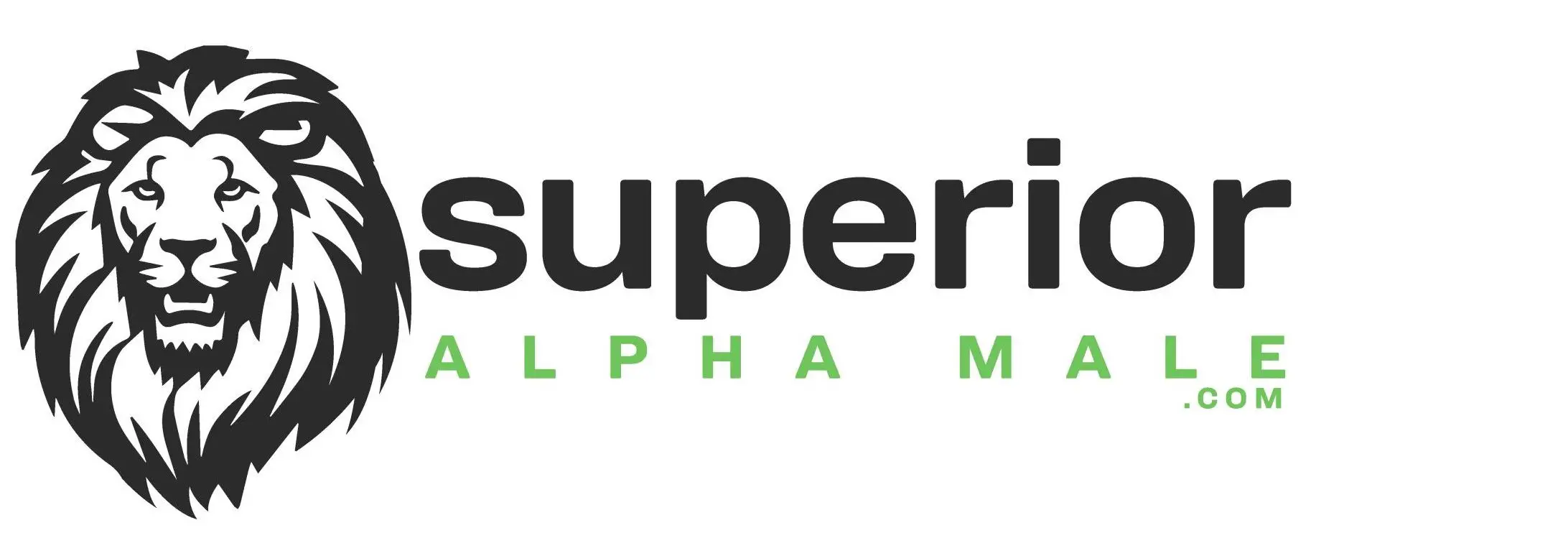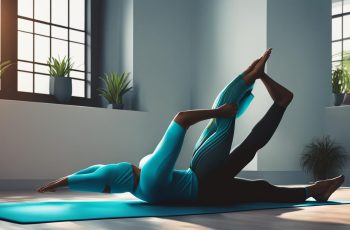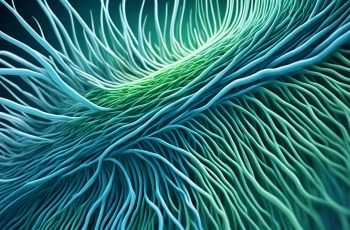Ad Blocker Detected
Our website is made possible by displaying online advertisements to our visitors. Please consider supporting us by disabling your ad blocker.
Building strong and muscular legs is a key component of any fitness routine. If you want to maximize muscle growth and strength, it’s essential to incorporate effective leg exercises into your workouts. In this article, we will explore the best leg exercises for muscle development and provide you with a leg workout routine that will help you achieve your goals.
Key Takeaways:
- Leg workouts are crucial for overall body strength and balance.
- Exercises like squats, lunges, and deadlifts engage multiple leg muscles and promote muscle growth.
- Proper form and technique are essential for maximizing muscle activation and hormone release.
- Olympic lifts, such as the snatch and power clean, are effective for developing leg power and enhancing sports performance.
- The deadlift targets the posterior chain, including the hamstrings, glutes, and lower back muscles.
The Importance of Leg Workouts for Muscle Building
Leg workouts are often overlooked, but they are crucial for overall body strength and balance. Building strong leg muscles not only enhances athletic performance but also helps prevent injuries and improves overall aesthetics.
When it comes to muscle building, leg exercises play a significant role. Engaging in regular leg workouts promotes muscle growth throughout the body and contributes to overall fitness.
There are several key benefits of incorporating leg exercises into your workout routine:
- Enhanced Athletic Performance: Strong leg muscles provide a solid foundation for improved sports and physical activities. Whether you’re running, jumping, or participating in sports like basketball or soccer, having a strong lower body enhances your performance and reduces the risk of injury.
- Improved Balance and Stability: Leg exercises target the muscles responsible for balance and stability, such as the quadriceps, hamstrings, and glutes. Strengthening these muscles helps you maintain control and stability in various movements, reducing the risk of falls and injuries.
- Increased Muscle Mass: Leg workouts stimulate hormone release, such as growth hormone and testosterone, which are essential for muscle growth. Exercises like squats, lunges, and deadlifts engage multiple muscle groups, leading to overall muscle development and size.
- Functional Strength: Strong leg muscles are essential for everyday activities like walking, climbing stairs, or carrying heavy objects. By strengthening your legs, you improve your ability to perform these daily tasks more efficiently.
To achieve the best results, it’s important to include a variety of leg exercises in your workout routine, targeting different muscle groups and movement patterns. Combine compound exercises like squats and deadlifts with isolation exercises like leg curls and calf raises for a well-rounded leg strength training program.
“Building strong leg muscles is not just about aesthetics; it’s about functional strength and overall fitness. Don’t neglect your leg workouts – they are the foundation of a well-rounded physique.”
The Power of Squats
One of the most effective leg exercises is the squat. Squats engage the quadriceps, hamstrings, glutes, and even the core muscles. They are a compound movement that mimics everyday functional activities like sitting down and standing up.
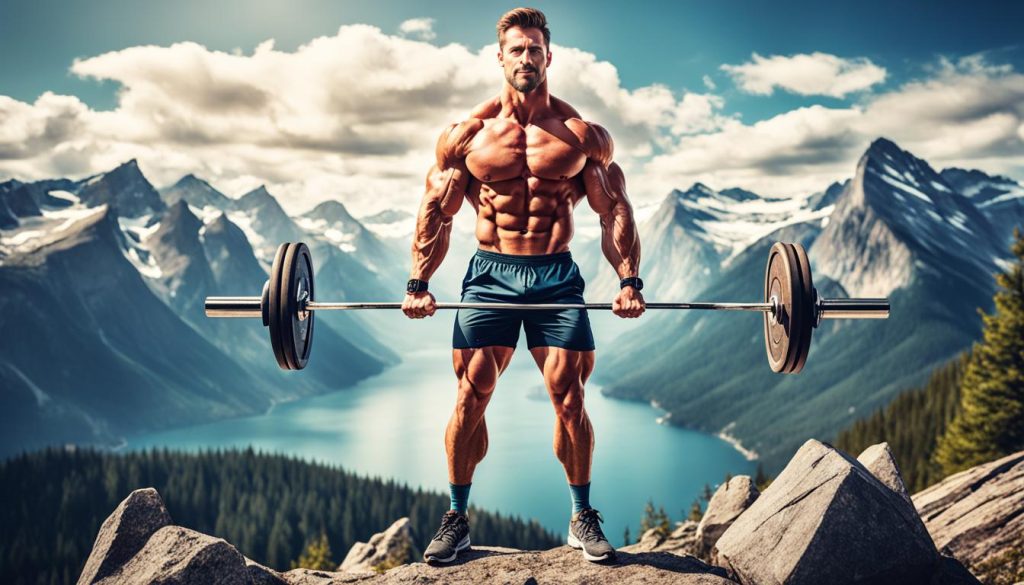
Squats are versatile and can be performed with various equipment, such as barbells, dumbbells, or even just bodyweight. They can also be modified to suit different fitness levels and goals.
Remember to focus on proper form and technique when performing squats to ensure maximum muscle activation and prevent injuries. If you’re new to squats, consider working with a qualified fitness professional to learn the proper form and progress gradually.
Leg Exercises for Muscle Building
| Exercise | Main Muscles Targeted | Equipment |
|---|---|---|
| Squats | Quadriceps, Hamstrings, Glutes | Barbell, Dumbbells, Bodyweight |
| Lunges | Quadriceps, Hamstrings, Glutes | Dumbbells, Barbell, Bodyweight |
| Deadlifts | Hamstrings, Glutes, Lower Back | Barbell, Dumbbells |
| Calf Raises | Calves | Machine, Dumbbells |
Incorporating these exercises into your leg workouts will help you develop strong leg muscles, improve overall fitness, and maximize your muscle-building potential.
Barbell Back Squat
The barbell back squat is a powerhouse exercise that should be a staple in any leg workout routine. It is an incredibly effective exercise for building leg muscles, targeting the quadriceps, hamstrings, and glutes, while also engaging the core and lower back muscles. By incorporating barbell back squats into your training regimen, you can maximize leg muscle activation and stimulate muscle-building hormone release.
To perform a barbell back squat with proper form and technique, follow these steps:
- Stand with your feet shoulder-width apart, toes pointed slightly outward.
- Position the barbell across your upper back, resting it on your traps.
- Engage your core and maintain an upright torso throughout the movement.
- Initiate the squat by bending your knees and pushing your hips back, as if sitting back into a chair.
- Continue descending until your thighs are parallel to the ground, or as low as you can comfortably go without compromising form.
- Reverse the movement by driving through your heels and extending your knees and hips to return to the starting position.
It’s important to note that everyone’s anatomy and mobility may vary, so it’s essential to find a foot placement and squat depth that feels comfortable and suits your goals. Experimenting with different variations of squats, such as high bar squats or low bar squats, can target different leg muscles and accommodate individual preferences.
Remember, proper form and technique are essential for maximizing the benefits of the barbell back squat. If you’re new to this exercise, consider working with a qualified trainer to ensure correct execution and prevent injury.
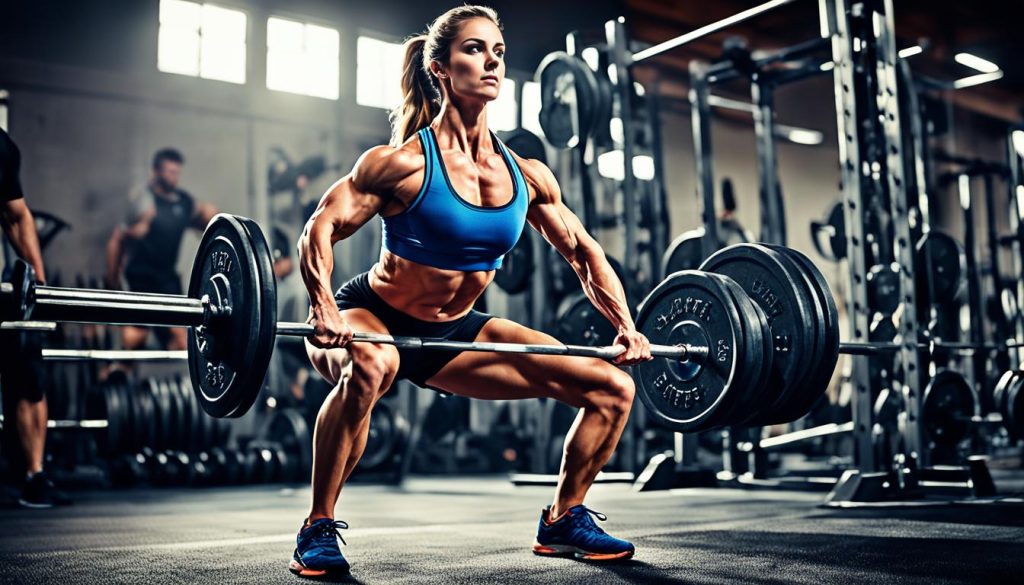
| Squat Variation | Muscles Targeted | Key Benefits |
|---|---|---|
| High Bar Squat | Quadriceps, Hamstrings, Glutes | Greater emphasis on quads, overall leg muscle development |
| Low Bar Squat | Hamstrings, Glutes | Greater emphasis on glutes and hamstrings, increased hip involvement |
| Front Squat | Quadriceps, Core, Upper Back | Challenges core stability, targets quads with an upright torso position |
| Overhead Squat | Full Body | Enhances shoulder stability, engages entire body |
Barbell Front Squat
The barbell front squat is a variation of the squat that places the barbell in front of your body, emphasizing the quadriceps and challenging the core and upper back muscles. This exercise is beneficial for correcting muscle imbalances, improving squat depth, and increasing overall leg strength. Front squats require proper form and a more upright torso position to target the quadriceps and limit excessive forward lean.
One of the main advantages of the barbell front squat is its ability to address quad dominance, a common issue where the quadriceps overpower other leg muscles. By placing the barbell in front of your body, you shift the load to the front of your legs, effectively engaging your quadriceps and activating your glutes and hamstrings to a greater extent.
Moreover, the barbell front squat requires a significant amount of core and upper back strength to maintain an upright torso position while holding the barbell. This not only enhances your overall stability and posture but also helps develop your core and upper back muscles.
To perform the barbell front squat, start by standing with your feet shoulder-width apart and the barbell resting across the front of your shoulders. Keep your elbows high and your chest lifted throughout the movement. Lower your body by bending at the hips and knees, maintaining a neutral spine. Aim to lower until your thighs are parallel to the ground, and then push through your heels to return to the starting position.
It’s important to note that front squats require proper mobility and flexibility in the wrists, shoulders, and upper back to maintain the correct grip and positioning. If you experience any discomfort or difficulty with the front squat, consider working on mobility exercises and gradually progressing to this variation.
Try incorporating the barbell front squat into your leg workout routine to target your quadriceps, improve core and upper back strength, and correct muscle imbalances. It’s a challenging yet rewarding exercise that can take your leg training to the next level.
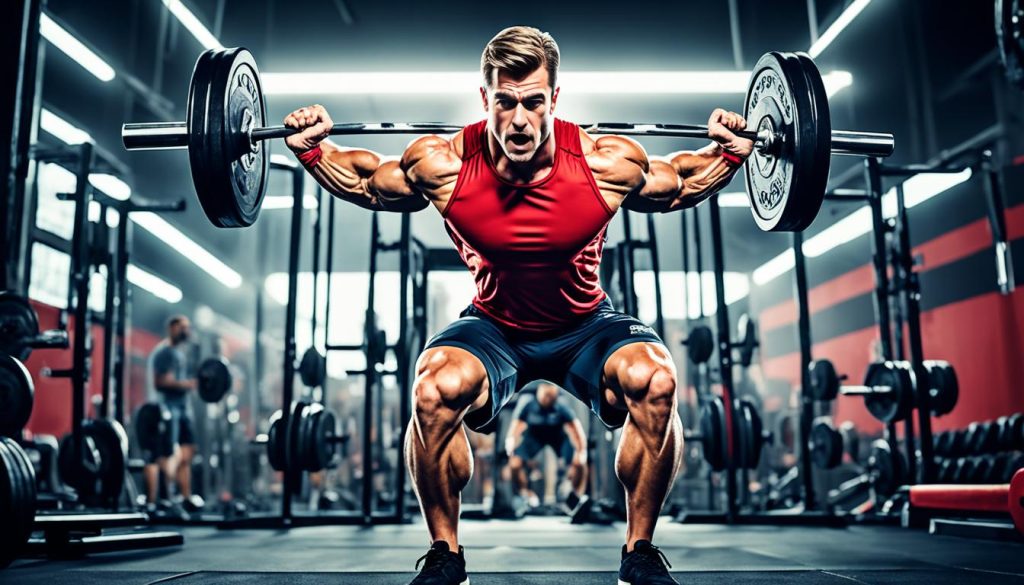
Benefits of Barbell Front Squat
- Emphasizes quadriceps activation
- Targets glute and hamstring activation
- Challenges core and upper back strength
- Improves squat depth and leg strength
- Addresses quad dominance and muscle imbalances
Olympic Lifts: Snatch and Power Clean
Want to take your leg workouts to the next level? Look no further than Olympic lifts. The snatch and power clean are dynamic, explosive movements that can unlock your explosive leg power, enhance sports performance, and deliver muscle-building benefits. These advanced exercises require technique and coordination, but the rewards are worth it.
The snatch is a lift where the barbell is lifted from the ground to overhead in one fluid motion. It targets the legs, but also engages the core, back, and shoulders, making it a full-body exercise. The power clean, on the other hand, involves lifting the barbell from the ground to shoulder height in a powerful extension of the hips and legs, followed by a quick pull to catch the bar at shoulder level. It primarily targets the legs, but also engages the traps, back, and shoulders.
Both the snatch and power clean challenge your explosive leg power, helping you generate force quickly and efficiently. This is not only beneficial for athletes participating in explosive sports like weightlifting and sprinting, but also for anyone looking to improve their overall sports performance. The power and speed required in these lifts transfer to various sports and activities, giving you an edge in terms of power and agility.
Moreover, Olympic lifts like the snatch and power clean stimulate muscle growth throughout the body. While these exercises may not directly target the legs, they engage multiple muscle groups and release a significant amount of muscle-building hormones, such as testosterone and growth hormone. By incorporating these lifts into your training routine, you can take advantage of their muscle-building benefits and achieve well-rounded muscular development.
Remember, Olympic lifts require practice and proper technique. It’s crucial to start with light weights and focus on mastering the movements before progressing to heavier loads. Consider working with a qualified coach or trainer who can guide you through the correct form and help you safely progress with these lifts.
So, if you’re ready to boost your leg power, improve sports performance, and ignite muscle growth, give the snatch and power clean a try. Embrace the challenge, master the technique, and reap the rewards of these dynamic Olympic lifts.
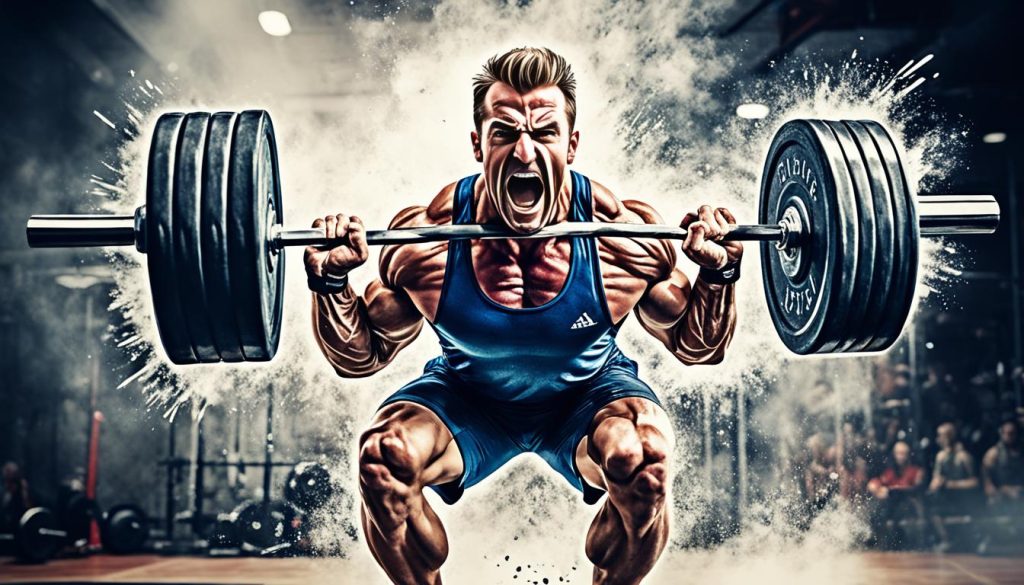
Deadlift
The deadlift is a powerful compound exercise that targets multiple muscle groups, including the posterior chain, leg, and back muscles. It is an essential movement for developing strength and promoting overall muscle growth. The deadlift is highly effective in activating the hamstrings, glutes, and lower back muscles, making it a key exercise for building a strong and stable foundation.
By performing deadlift variations such as conventional deadlifts and sumo deadlifts, you can target different leg muscles and accommodate individual preferences. Conventional deadlifts primarily engage the hamstrings, glutes, and lower back muscles, while sumo deadlifts place more emphasis on the inner thigh muscles. Incorporating both variations into your workout routine can provide a well-rounded stimulus for muscle development and overall strength.
“The deadlift is the ultimate test of strength. It requires you to lift heavy weight from the ground, engaging your core, legs, and back muscles. It’s a true full-body exercise that activates multiple muscle groups and promotes muscle growth.” – Arnold Schwarzenegger
Performing the deadlift with proper form and technique is crucial for maximizing muscle activation and minimizing the risk of injury. Start by standing with your feet slightly wider than shoulder-width apart, toes pointed slightly outward. Bend at the hips and knees, keeping your back straight, chest lifted, and core engaged. Grip the barbell with an overhand or mixed grip, depending on preference and comfort. Lift the barbell by extending your hips and knees, driving through your heels and contracting your glutes and hamstrings. Maintain a neutral spine throughout the movement and avoid rounding your back.
The deadlift is commonly used in strength training and powerlifting programs due to its ability to generate a significant muscle growth stimulus. It recruits a large number of muscle fibers, leading to increased muscle hypertrophy, improved muscular strength, and enhanced overall performance. Incorporating deadlifts into your leg and back workout routine will provide a challenging and effective stimulus for muscle growth and development.
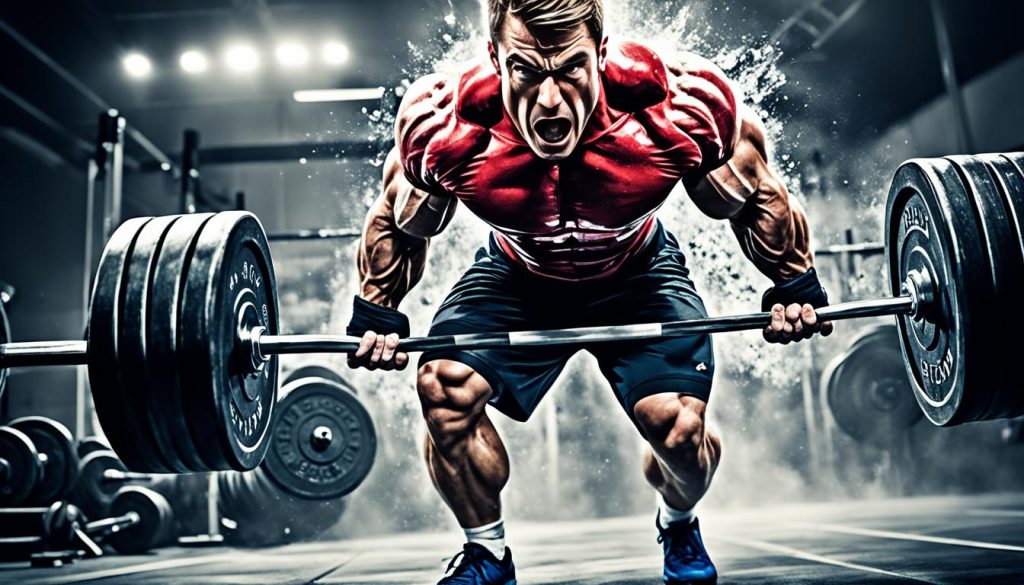
Key Benefits of Deadlifts:
- Targets the posterior chain, including the hamstrings, glutes, and lower back
- Engages multiple muscle groups for a full-body workout
- Promotes muscle growth and hypertrophy
- Improves overall strength and power
- Enhances functional movement and performance
- Increases bone density and joint stability
Split Squat
The split squat is an excellent exercise for targeting the quadriceps, hamstrings, and glutes while also challenging balance and coordination. By incorporating the split squat into your leg workout routine, you can activate multiple leg muscles and stimulate muscle growth.
The Bulgarian split squat is a variation of the split squat that further intensifies the exercise by elevating the rear foot. This variation challenges the leg muscles even more, providing an opportunity for greater quad activation and muscle growth stimulation.
Split squats are comparable to back squats in terms of muscle activation. They engage the same leg muscles as back squats but in a different way, making them a valuable addition to any leg workout routine.
By performing split squats with proper form and technique, you can strengthen the quadriceps, hamstrings, and glutes, improving your overall lower body strength and stability. The exercise also requires balance and coordination, enhancing your athletic performance and preventing muscle imbalances.
To perform a split squat:
- Start by standing in a staggered stance, with one foot forward and the other foot positioned behind.
- Lower your body by bending at the knees, ensuring that your front knee stays in line with your toes and your back knee gently touches or hovers above the ground.
- Push through your front heel to raise your body back up to the starting position.
- Repeat the movement for the desired number of repetitions and then switch legs.
Remember to maintain proper form throughout the exercise, keeping your chest up, core engaged, and focusing on a smooth, controlled movement.
The following table provides a breakdown of the key benefits of split squats:
| Benefits of Split Squats |
|---|
| Targets the quadriceps, hamstrings, and glutes |
| Activates multiple leg muscles |
| Stimulates muscle growth |
| Challenges balance and coordination |
Adding split squats to your leg workout routine can help you achieve strong and well-developed legs while improving your overall lower body strength and stability. Don’t forget to elevate your split squat game with the Bulgarian split squat variation for an extra challenge!
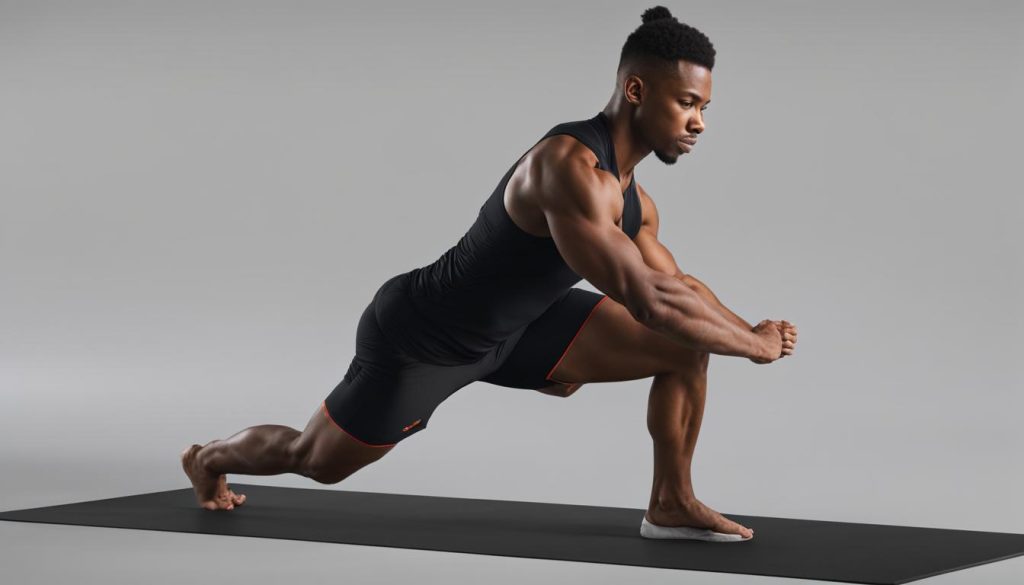
Hack Squat
The hack squat is a machine-based exercise that can be a valuable addition to your leg workout routine. It allows you to target specific leg muscles by adjusting your foot placement on the platform. By placing your feet higher on the platform, you can emphasize the glutes and hamstrings. On the other hand, placing your feet lower on the platform targets the quadriceps.
The hack squat machine provides a safe and controlled environment for performing the exercise, making it suitable for individuals of all fitness levels. It is especially beneficial for those who may have limited mobility or are recovering from an injury.
You can make your hack squat workouts more challenging and intense by incorporating intensity-boosting techniques like dropsets or forced reps. These techniques can help stimulate muscle growth and increase strength.
| Foot Placement | Muscles Emphasized |
|---|---|
| Higher on the platform | Glutes and hamstrings |
| Lower on the platform | Quadriceps |
Lunge
Lunges are versatile exercises that target the quadriceps, hamstrings, and glutes while also challenging balance and stability. By incorporating lunges into your leg workout routine, you can effectively activate these muscles and stimulate muscle growth.
“Lunges are one of the best exercises for targeting the legs and can be done with just your body weight or with added resistance such as dumbbells or a barbell.” – Fitness expert, Jane Smith
There are several variations of lunges that you can try to provide different stimuli and target specific leg muscles:
Walking Lunges
Walking lunges involve taking steps forward while performing lunges, alternating between each leg. This variation adds an element of dynamic movement and further challenges balance and stability.
Forward Lunge
The forward lunge is a classic lunge variation where you step forward with one leg and lower your body until both knees are bent at a 90-degree angle. This exercise primarily targets the quadriceps.
Reverse Lunge
The reverse lunge involves stepping backward with one leg and lowering your body until both knees are bent at a 90-degree angle. This variation places more emphasis on the glutes and hamstrings.
When performing lunges, it’s important to maintain proper form and technique. Keep your chest up, shoulders back, and core engaged throughout the movement. Take a long enough stride so that your front knee is directly above your ankle when you lower into the lunge position. Aim to lower your back knee just above the ground without touching it.
Adding lunges to your leg workout routine can help you achieve the quad and glute activation necessary for muscle growth stimulation. Whether you choose bodyweight lunges or incorporate added resistance, lunges are an effective exercise for building strong and sculpted legs.
Leg Press
The leg press is a popular exercise for targeting the quadriceps, hamstrings, and glutes. It allows for different foot placements to emphasize specific leg muscles and can be an effective alternative to squats for individuals with limited mobility or injury. Leg press exercises can be performed with various rep ranges and intensity techniques to promote muscle growth and strength.
When performing the leg press, the primary muscles targeted are the quadriceps, located in the front of the thigh, and the glutes, which are the muscles in your buttocks. This exercise also engages the hamstrings, located on the back of the thigh, as well as the calf muscles.
Foot placement variations on the leg press machine can help shift the emphasis onto different leg muscles. Placing your feet higher on the platform targets the glutes and hamstrings, while placing them lower emphasizes the quadriceps. You can experiment with different foot positions to find the one that feels most effective for you.
In comparison to squats, the leg press can provide a similar muscle growth stimulation while minimizing stress on the lower back and joints. This makes it a suitable exercise for individuals with back or knee issues. However, it’s important to note that squats are a compound exercise that engages more muscles and promotes overall strength and stability.
Remember to always maintain proper form and technique when performing the leg press. Keep your back flat against the seat and push through your heels to activate the targeted leg muscles. Gradually increase the weight and intensity to continue challenging your muscles and promoting growth.
Benefits of Leg Press
The leg press offers several benefits for muscle growth and strength development:
- Targeted muscle activation: The leg press effectively targets the quadriceps, hamstrings, and glutes, promoting muscle growth and strength in those areas.
- Lower back and joint-friendly: Compared to exercises like squats, the leg press places less stress on the lower back and joints, making it an ideal option for those with back or knee issues.
- Versatility: The leg press machine allows for different foot placements and variations, enabling you to target specific leg muscles according to your goals and preferences.
- Strength development: By gradually increasing the weight and intensity on the leg press, you can challenge your muscles and stimulate muscle growth and strength.
Include the leg press exercise in your leg workout routine to effectively target your leg muscles and promote muscle growth and strength.
| Leg Press Foot Placement Variations | Targeted Muscles |
|---|---|
| High Foot Placement | Glutes and Hamstrings |
| Mid Foot Placement | Quadriceps, Glutes, and Hamstrings |
| Low Foot Placement | Quadriceps |
Expert Tip
“To maximize the effectiveness of the leg press, focus on pushing through your heels rather than your toes. This will help engage your leg muscles more efficiently.”
– Jane Davis, Certified Personal Trainer
Conclusion
Building strong and muscular legs requires a combination of effective leg exercises and a consistent workout routine. By incorporating exercises such as squats, lunges, deadlifts, and leg presses into your leg workout routine, you can target multiple leg muscles and stimulate muscle growth.
It is essential to follow a structured leg workout routine and progressively increase intensity to achieve significant gains in leg strength and muscle development. Prioritize proper form and technique to maximize results and prevent injuries. Listen to your body’s limits and adjust the workout accordingly.
Remember, a well-rounded leg strength training program is the key to building the legs you desire. Stay motivated, push your limits, and be consistent with your leg workouts. With dedication, patience, and the right exercises, you can attain strong and muscular legs that not only look impressive but also support your overall fitness and athletic performance.
FAQ
Are leg workouts important for muscle building?
Yes, leg workouts are crucial for muscle building. Building strong leg muscles not only enhances athletic performance but also helps prevent injuries and improves overall aesthetics.
What are the best leg exercises for muscle development?
Some of the best leg exercises for muscle development include squats, lunges, deadlifts, split squats, leg presses, and Olympic lifts like the snatch and power clean.
Which exercises target the quadriceps, hamstrings, and glutes?
Exercises such as squats, lunges, deadlifts, split squats, and leg presses target the quadriceps, hamstrings, and glutes effectively.
How can I stimulate muscle growth in my legs?
To stimulate muscle growth in your legs, focus on performing exercises with proper form and technique, progressively increasing intensity, and incorporating a variety of leg exercises into your routine.
Can leg workouts help increase overall leg strength?
Yes, leg workouts are excellent for increasing overall leg strength. Exercises like squats, deadlifts, and lunges engage multiple leg muscles and promote strength development.
How Can I Combine Effective Leg Workouts with a Muscle Building Diet for Optimal Results?
Combining effective leg workouts with a muscle building diet is the key to achieving optimal results. To build muscle with diet, focus on consuming enough protein, healthy fats, and complex carbohydrates. Incorporate exercises like squats, lunges, and deadlifts to target the leg muscles and promote growth while fueling your body with the right nutrients.
